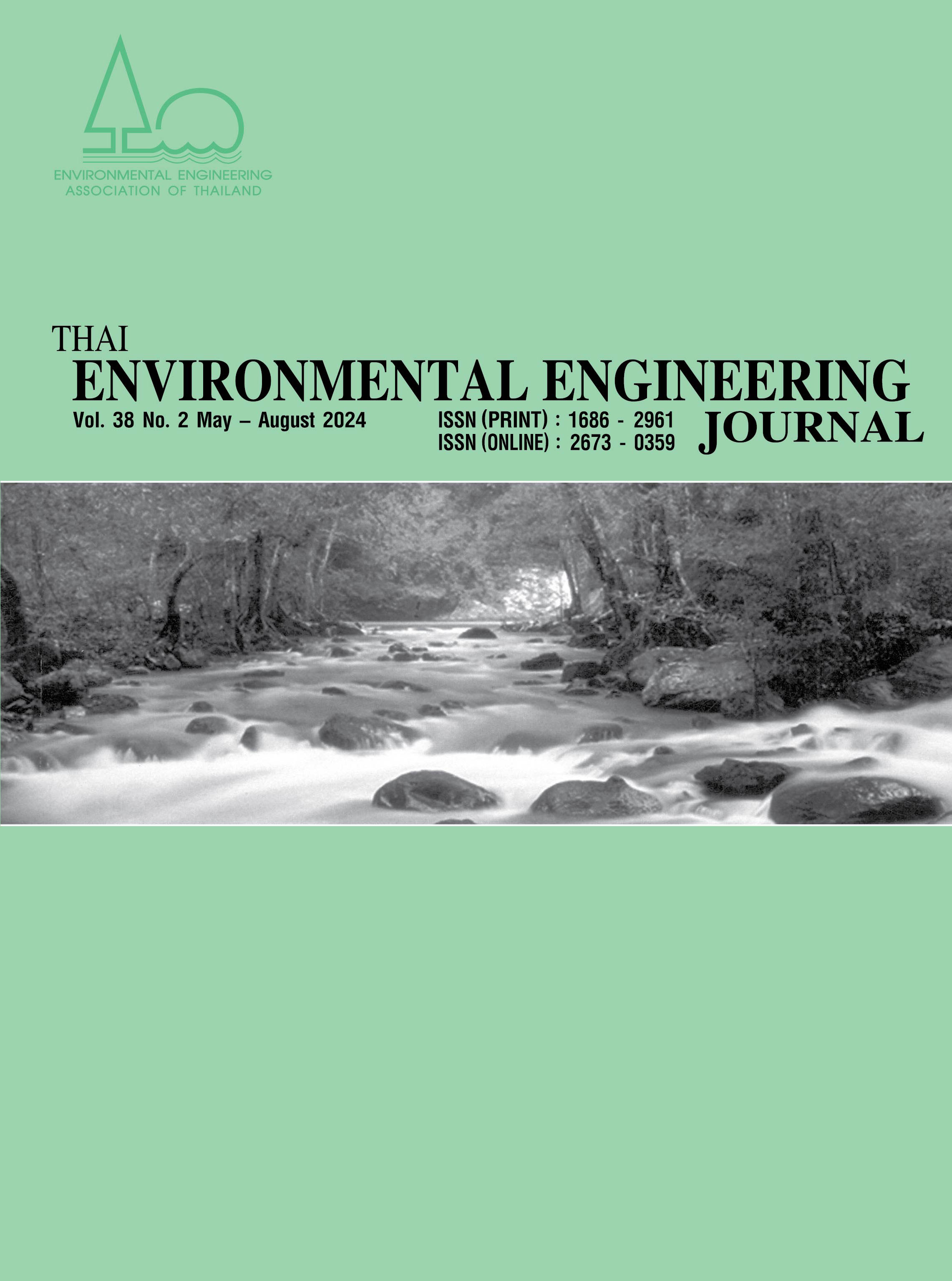Impact of Feedstock Density on Biodrying for Enhancing Heat Retention and Moisture Reduction
Main Article Content
Abstract
This study examines the effect of varying feedstock densities on the performance of biodrying processes to enhance waste management efficiency. Three different densities of wet- refuse-derived fuel 3 (wet-RDF3) from Bangkok's On Nut Transfer Station were tested using lysimeter reactors with constant aeration rates (0.6 m3/kd.day). Results revealed that a moderate density (230 kg/m3) achieved the highest temperature integration index (7218.01°C) and demonstrated effective moisture reduction and minimal volatile solids consumption. The higher densities improved heat retention and prolonged thermophilic conditions, optimizing the biodrying process. These findings highlight the importance of feedstock density in biodrying, suggesting that optimal density can significantly improve waste drying efficiency and produce better quality refuse-derived fuel. This approach offers a sustainable solution for waste management, particularly in developing countries.
Article Details
References
Khan, A. H., Lopez-Maldonado, E. A., Khan, N.A., et al. 2022. Current solid waste management strategies and energy recovery in developing countries - State of art review. Chemosphere, 29(3): 133088.
Shovon, S. M., Akash, F. A., Rahman, W., et al. 2024. Strategies of managing solid waste and energy recovery for a developing country – A review. Heliyon, 10(2): e24736
Ferronato, N. and Torretta, V. 2019. Waste Mismanagement in Developing Countries: A Review of Global Issues. Inter J Environ Res Public Healt, 16(6): 1060.
İnce, E., İnce, M., and Önkal E. G. 2017. Comparison of thermophilic and mesophilic anaerobic treatments for potato processing wastewater using a contact reactor. Glob. Nest J, 19: 318-326.
Zaman, B., Hardyanti, N., Purwono, P., Suryantara, A. R., Putri, N.S. and Failusuf, T.A.M. 2023. Application of biodrying with hot air aeration system to process solid waste into rdf. IOP Conference Series: Earth and Environmental Science, 1268(1): 12034.
Guerra-Gorostegi, N., González, D., Puyuelo, B., et al. 2021. Biomass fuel production from cellulosic sludge through biodrying: Aeration strategies, quality of end-products, gaseous emissions and techno-economic assessment. Waste Management, 126: 487-496.
Özbay, İ., Özbay, B. and Akdemir, U. 2022. Biodrying for fuel recovery from sewage sludge: An integrated evaluation by ultimate and proximate analyses. Environmental Progress and Sustainable Energy, 41(1).
Yuan, J., Li, Y., Wang, G., et al. 2019. Biodrying performance and combustion characteristics related to bulking agent amendments during kitchen waste biodrying. Bioresourch Technology, 284: 56-64.
Contreras-Cisneros, R.M., Orozco-Álvarez, C, Piña-Guzmán, A.B., et al. 2021. The Relationship of Moisture and Temperature to the Concentration of O2 and CO2 during Biodrying in Semi-Static Piles. Processes, 9(3).
Pecorini, I., Bacchi, D. and Iannelli, R. 2020. Biodrying of the Light Fraction from Anaerobic Digestion Pretreatment in Order to Increase the Total Recovery Rate. Processes, 8(3).
Bosilj, D., Petrovic, I., Hrnic, N. and Kaniski, N. 2024. Biodrying of municipal solid waste–correlation between moisture content, organic content, and end of biodrying process. Environmental Science and Pollution Research, 1-14.
Tom, A. P., Haridas, A. and Pawels, R. 2016a. Biodrying Process Efficiency: Significance of Reactor Matrix Height. Procedia Technology, 25: 130-137.
Itsarathorn, T., Towprayoon, S., Chiemchaisri, C., et al. 2023. The Effect of Aeration Rate and Feedstock Density on Biodrying Performance for Refuse-Derived Fuel Quality Improvement. International Journal of Renewable Energy Development, 12(6): 1091-1103.
Dharmasyah, D.F., Anasstasia, T.T., Utami, A., Widiarti, I.W. and Alfiani, O.D. 2023. Inorganic Waste Management and Energy Potential: Implications for Agricultural Sustainability. IOP Conference Series: Earth and Environmental Science, 1242(1).
Sagala, G., Kristanto, G.A., Kusuma, M.A. and Rizki, S. 2018. Assessment of Municipal Solid Waste as Refuse Derived Fuel in the Cement Industry. International Journal on Advanced Science Engineering and Information Technology, 8(4).
Tom, A. P., Haridas, A. and Pawels, R. 2016b. Biodrying process: A sustainable technology for treatment of municipal solid waste with high moisture content. Waste Management, 49: 64-72.
Hao, Z. and Jahng, D. 2019. Variations of organic matters and extracellular enzyme activities during biodrying of dewatered sludge with different bulking agents. Biochemical Engineering Journal, 147: 126-135.
Sutthasil, N., Ishigaki, T., Ochiai, S., Yamada, M. and Chiemchaisri, C. 2022. Carbon conversion during biodrying of municipal solid waste generated under tropical Asian conditions. Biomass Conversion and Biorefinery, 13: 16791-16805.
Ma, J., Zhang, L., Mu, L., Zhu, K. and Li, A. 2019. Energetic enhancement of thermal assistance in the cooling stage of biodrying by stimulating microbial degradation. Waste Management, 89: 165-176.
Huiliñir, C., Leiva, E., Stegmaier, F., Castillo, A., Cottet, L. and Montalvo, S. 2020. Biodrying of dewatered secondary sludge: behavior of dynamic respiration index (DRI) and energy release under different operating conditions. Journal of Chemical Technology & Biotechnology, 95(1): 94-101.
Bhatsada, A., Patumsawad, S. and Wangyao, K. 2023. Effect of Negative Aeration Rates on Water Balance in Biodrying of Wet-Refuse-Derived Fuel. Thai Environmental Engineering Journal, 37(1): 55-63.
Hu, Z., Hao, Z., Lei, H., et al. 2023. Effect of Bulking Agents on Dewatered Sludge Biodrying Followed by Thermal Drying. Processes, 11(5): 1392.
Xu, M., Sun, H., Yang, M., et al. 2023. Effect of biodrying of lignocellulosic biomass on humification and microbial diversity. Bioresource Technology, 384: 129336.
Li, J., Ju, T., Lin, L., et al. 2022. Biodrying with the hot-air aeration system for kitchen food waste. Journal of Environmental Management, 319: 115656.
Wang, K., Chen, Y., Cao, M. K., Zheng, G.D. and Cai, L. 2024. Influence of microbial community succession on biodegradation of municipal sludge during biodrying coupled with photocatalysis. Chemosphere, 349: 140901.
Ham, G.Y. 2020. Study on Bio-drying MBT by modelling of moisture removal and evaluation as MSW management system for energy recovery. (Doctoral Dissertation, Hokkaido University).
Payomthip, P., Towprayoon, S., Chiemchaisri, C., Patumsawad, S., and Wangyao, K. (2022). Optimization of Aeration for Accelerating Municipal Solid Waste Biodrying. International Journal of Renewable Energy Development, 11(3): 878-888.
Cao, X., Gao, J., Wang, Z., et al. 2024. Rapeseed cake (RSC) as a novel bulking agent for accelerated biodrying of dewatered sludge. Journal of Environmental Chemical Engineering, 12(3): 112526.
Quan, H., Zhu, T., Ma, F., et al. 2023. Enhanced bio-drying effect in low-temperature: Characteristics of sludge hyperthermophilic aerobic bio-drying by inoculating with thermophilic bacteria and full-scale operation. Drying Technology, 41(12): 1977-1990.


